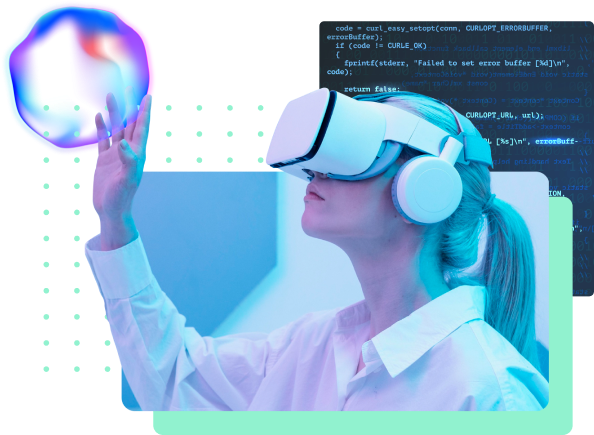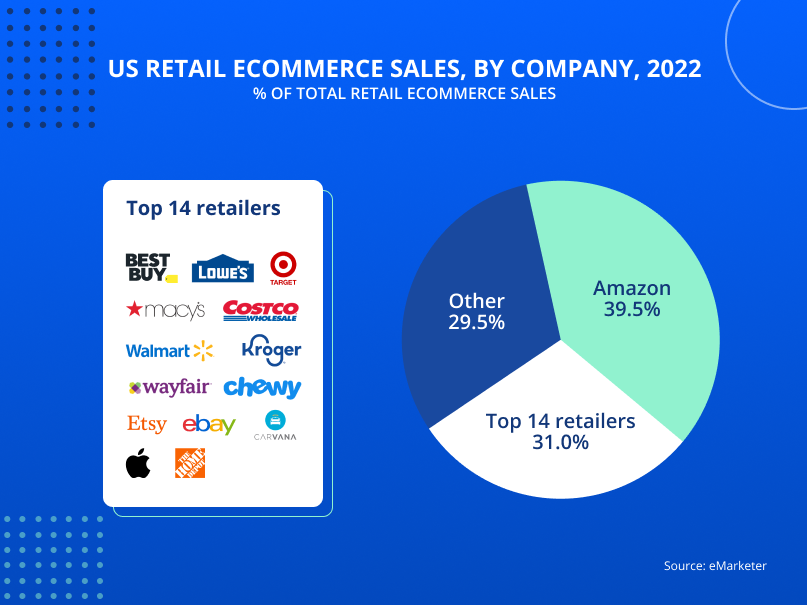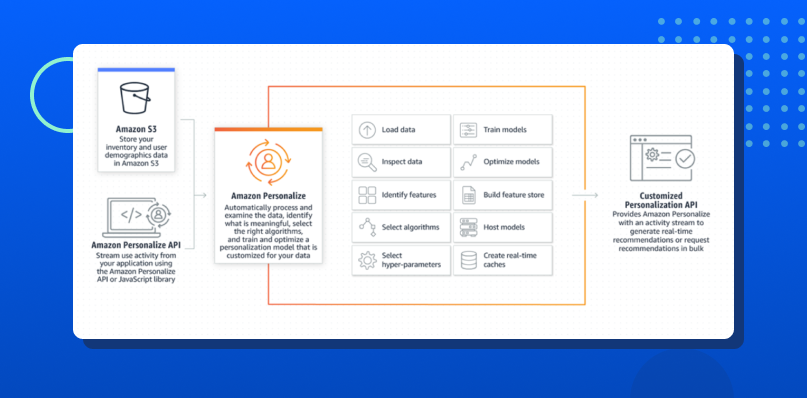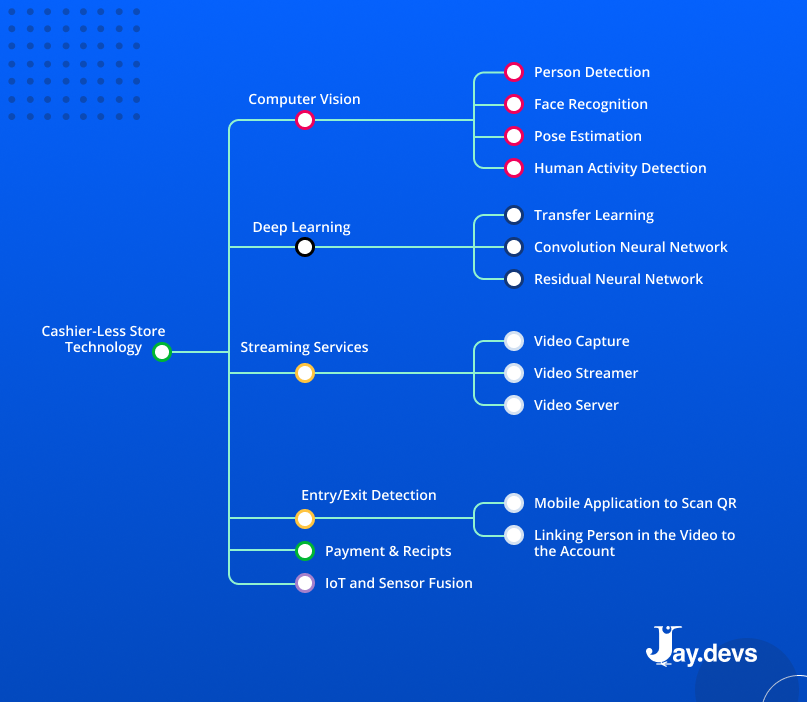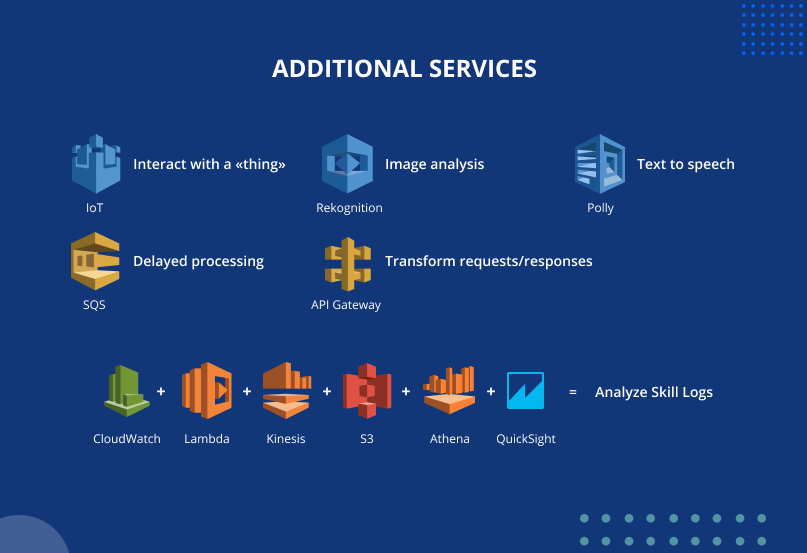Whether you like Amazon or not, it’s hard to resist admiring the constant tenacity and ingenuity of the company. Starting in 1995 as a modest online marketplace for books in Seattle, the company has been annually growing at about 21% over the past decade. Amazon’s 2021 net online sales revenue comprised $222.08 billion.
In just 27 years, the company has changed the way we live, work, and shop. 65% of Internet users start searching for products on Amazon. As of June 2021, Amazon was the most visited e-commerce site in the US with approximately 2.45 billion monthly visits to Amazon.com.
In 2022, Amazon ranks first among all US retailers. Its growth was driven by a rather vague mission of the company aiming at becoming “To be Earth’s most customer-centric company”. And they wouldn’t have achieved their goal if they weren’t one of the first companies to use AI. The use of artificial intelligence in e-commerce helped Amazon drive up its profits and boost performance.
With all the great variety of online stores, Amazon remains the largest. One can hope that Mr. Bezos will make a mistake or that some new trend might bewilder him. Both options might happen, however, this is not a business strategy. Instead of unlikely hopes, one should learn from Amazon, borrow, and implement their best practices. In this article, we will cover these trends and show how to use them.
- 1. Amazon Recommendation Engine
- 1.1. A Technical Overview of Amazon’s Recommendation Engine
- 1.2. Benefits of a Product Recommendation Engine
- 2. Amazon Go
- 2.1. Cashierless Just Walk Out Technology
- 2.2. Benefits of a Cashierless Checkout Technology
- 3. Alexa Audio Interface
- 3.1. A Technical Overview of Alexa Technology
- 3.2. Benefits of a Voice Assistant Technology
- Conclusion
Amazon Recommendation Engine
Recommendation system is a powerful personalization tool. Personalization is a way to show people goods they might like but are unlikely to discover themselves. Leveraging a personalized approach, the online store recommends precisely the products that the customer is ready to buy. As Steve Jobs said, “a lot of times, people don’t know what they want until you show it to them”. Back in 2020, 63% of surveyed US businesses mentioned that personalization increased their conversions.
Amazon’s first patent for a recommendation system was registered in 2001. According to a McKinsey study, over 35% of Amazon sales are generated by recommendation algorithms.
The main types of recommendations shown by Amazon include:
- Recommended for you. The user logs into his Amazon.com account and sees his personal product recommendations in different categories. That means if the client goes to the recommendations page for the household supplies section the most popular detergents, dishwashing supplies, etc. will be shown based on the recent purchasing history. Products that are often bought are considered to be worth.
- Related Products. The customer opens a product description, and at this time, Amazon makes recommendations for products that are similar to those that the user recently viewed. These recommendations are based on the user’s browsing history, and the recommended products usually vary in shape, size, and brand.
- Products frequently bought together/ Customers who bought this item also bought/ Recommended for you based on previous purchase. To increase the order price, Amazon makes recommendations for the products purchased together. These recommendations aim to encourage customers to purchase additional products (so-called up-selling) or buy another product or service (so-called cross-selling). They are shown by providing suggestions based on the products the user has already added to the shopping cart or as a recommendation below the description of a product being currently reviewed. For example, if users buy an iPad from Amazon, they can get recommendations for iPad cases on the next order step page. Similar recommendations also pop up on the home page.
A Technical Overview of Amazon’s Recommendation Engine
The AI-based recommendation system stands on machine learning algorithms. Machine learning is an area of AI that learns to independently solve problems based on the analysis of structured data according to specified criteria. Unlike conventional recommendation systems suggesting products to customers based on popularity or common knowledge (like best-selling books or most frequently bought items), machine learning algorithms search for patterns in a customer’s purchases. This approach helps to predict: which goods may be liked and which not.
The company has its own Amazon Personalize tool for personalized recommendations which is also available on AWS. Amazon Personalize is a fully managed machine learning service. User platform activity, product metadata (product details), and user metadata (age, location) are transferred to Amazon Personalize. Amazon Personalize validates this data, identifies unique features, selects hyperparameters, trains and optimizes models, and performs many internal functions before users get their personalized recommendations.
Check the developers’ guide to learn more about how Amazon personalization uses data to train recommendation models and how to integrate this system for your solutions. You might also take a look at the Amazon Personalize Cheat Sheet on GitHub for more examples of how to use the various features of Amazon Personalize.
Benefits of a Product Recommendation Engine
Increasing your sales is the main reason why you should be using a recommendation system. It happens due to:
- More opportunities for cross-sales and upselling. 49% of consumers said they purchased a product after receiving a personal recommendation, even though they had no intention of purchasing.
- Conversion increase. Personalization increases its likelihood of visitors staying on the page longer and continuing browsing. Sequentially, this will increase your click-through rate and conversion.
- Decreased cart abandonment rates. Baymard Research Institute calculations revealed that the average cart abandonment rate comprises 69.99%. This means that almost seven out of ten buyers leave your site without completing their purchase. Recommendation systems can improve the cart abandonment rate by 35.26%.
- Increased time spent in the store. When customers spend more time in your store, they are also more likely to purchase from you. On average, shoppers clicking on a product recommendation spend 12.9 minutes on the site versus 2.9 minutes for those who don’t follow product recommendations.
Amazon Go
Back in the day, innovations in retail mostly affected the field of payments. Remember how in the past cash was the only option to pay? Then POS terminals appeared and credit cards could be used for payment. Then everyone was faced with self-service checkouts. Well, now Amazon Go has revolutionized everything again with its full automation.
In many ways, Amazon Go is like any other store. But unlike other stores there are no cash desks or human cashiers: the moment of purchase is recorded by AI.
Shoppers have three options to enter: scan a QR code on the Amazon app, use Amazon One to scan their palm, or simply insert a credit or a debit card linked to an Amazon account. All further actions are without any cash desks due to Just Walk Out technology.
A Technical Overview of Cashierless Just Walk Out Technology
Amazon’s cashierless Just Walk Out technology consists of computer vision, IoT cameras and sensors, and deep learning. Cameras track the actions of each customer, and sensors on the shelves record when items are taken or returned. The AI algorithms identify the shopper’s actions, pair them with sensor information, debit the Amazon shopper’s account as they exit the store, and send them a receipt.
- Computer vision. This technology allows machines to “see” what is in front of them and determine the object. It enables the system to see when the product was taken from the shelf by the buyer and who took it. The system is also capable of removing an item from a customer’s virtual shopping cart if it is put back on the shelf.
- Computer vision is based on deep learning. In a nutshell, this is an advanced image recognition system from a huge array of data. For example, we have a person and an apple. Deep learning ensures that payment for an item is made by the customer who actually took that item from the shelf.
- IoT and Sensor Fusion. The system records the weight of goods. Weight change can indicate that the product was taken from the shelf. But for less obvious things (such as containers with different salads), RFID sensors read by scanners throughout the store are used. This helps the AI to determine what was taken by the shopper when the weight of the goods is small and the picture on the camera is not sharp enough.
Benefits of a Cashierless Checkout Technology
Innovation is vital for any retail company to stay competitive. Margin is the cornerstone for using cashierless checkout technology. Findings of 451 Research reveal that slow queues cost approximately $37.7 billion in potential sales per year. If shoppers don’t have to stand in queues and wait while items are scanned one by one, stores can sell more. However, there are more pros of cashierless technology to keep in mind:
- Theft and fraud reduction. According to NASP findings, more goods for over $13 billion are stolen from retailers every year (roughly $35 million a day). AI can monitor and block insecure content, as well as to detect anomalies in customer behavior, and request identification. For instance, during the Black Lives Matter protests, participants broke the windows of the Amazon Go store in Seattle. Several people decided that if they didn’t scan their barcode at check-in, the store wouldn’t be able to bill them. They were wrong. Cameras helped neural networks identify the shoplifters and they all received their receipts.
- Fewer cashiers required. The absence of cashiers does not mean the absence of employees. Your team members can be employed on different levels. For example, place your staff in strategic areas of the store, let them check IDs when selling alcohol, or engage them in restocking and customer assistance.
- Acquisition of large data amounts. The use of AI enables more careful data collection helping to better understand your customers revealing the potential for shopping experience manipulation. For instance, you can find out where people spend the most time in your store, places they don’t go at all, whether the goods are placed conveniently, etc.
- Goods availability monitoring. The system of sensors and cameras knows the content of every shelf. This means it can immediately notify store employees when they start running out of goods on a particular shelf, or when a customer misplaces an item or puts it on the wrong shelf.
Alexa Audio Interface
Statista predicts that over 8.4 billion voice assistants will be in use worldwide by 2024, and over 51% of users will use them to shop online. This data is leading to the next revolution — voice commerce.
Voice commerce is based on artificial intelligence. AI helps you make purchases using your voice and a smart device: a mobile phone or a smart speaker.
There are plenty of voice assistants: Google Assistant, Siri, Bixby, etc. However, Alexa is still the only one that allows customers to directly buy products using voice commands. With Alexa, shoppers can ask for product recommendations, reorder basic consumer goods, add items to shopping lists, and track packages.
A Technical Overview of Alexa Technology
Alexa’s Brain consists of several services being a kind of artificial intelligence assistant.
Natural Language Processing (NLP) is Alexa’s core technology or concept. NLP helps machines understand and process human language. It converts the text into structured data.
In a nutshell, Alexa works as follows:
- The audio is converted into a digital audio stream. Echo records audio, digitizes it, encodes it, and sends it as a digital audio stream to the cloud-based Alexa processing infrastructure.
- The speech recognition system processes the digital audio stream, recognizes speech and converts it into text.
- After Alexa analyzes the text and defines the user’s need it sends a skill request that can help address the need. “Skills” are referred to as third-party applications that enhance Alexa with all new functions and features. For instance, Ocado, an online food retailer, created its Skill on Amazon. The customer can simply say, “Alexa, ask Ocado to add milk to my order.” Alexa will be able to do this because the client has the Ocado Alexa Skill app.
- The recognized text and found external Skills are used to define the intention and slots (additional parameters) from the text.
- The intention and slots are converted to response text. Alexa calls the Skill Service associated with the skill and passes in the intention name, optional slots, and context information. The Skill Service considers context and parameters and returns a text response as a string.
- The response text is converted into a digital audio stream. Alexa plays this audio stream. In fact, Alexa reads the text and sends an audio stream to the user’s Echo device.
- The Echo device plays a digital audio stream to the user.
Benefits of a Voice Assistant Technology
By 2025, voice commerce sales will reach $164 billion worldwide. Major e-commerce brands such as Amazon with Alexa are already leading in implementing voice trading solutions. However, much of the industry has still not embraced this booming market. And this might be your advantage and opportunity.
Voice technology integration into e-commerce helps retailers improve their customer experience. A better customer experience increases conversions and repeated purchases – the most cherished dream of every retailer. So what are your anticipated benefits from a voice assistant?
- Quick Sales. With voice commerce, the customers don’t need to log in or fill out their personal details in an online store to purchase an item online.
- Increase of repeat orders. The voice interface also sends voice notifications to remind you to purchase an item you will run out of soon. Say a customer ordered coffee for a month and the reminder to re-order is sent on the 25th day after the purchase.
- Increase brand credibility. If you build loyal relationships with your customers, the most trusted brands will rise to the top leaving the competition far behind. However, to do this, you should create digital assistants that do not just sell goods but are a trusted source of information. For example, Tide Skill in Alexa is ready to answer any question about how to remove a blueberry or marker stain. Tide has an answer for everything. It is very important to treat voice assistants, not as trendy tinsel, but as a handy tool to solve real problems aiming at creating a deeper relationship with your customers.
- Competitive advantage in the marketplace. The newness of voice commerce still makes this sector untapped. By implementing voice commerce in your store you will immediately get ahead of the competition.
To conclude
Contemporary customers demand modern solutions. We live in a world where speed, efficiency, and convenience are the top priority. AI provides vast opportunities for the future of e-commerce. Some solutions require more time and cost than others. But both buyers and retailers will surely benefit from the results obtained.
If you have ideas on how to implement the above trends in your business with the help of AI, we’ll be happy to help. Jaydevs is a successful developer of innovative software products leveraging AI. Feel free to learn more about Jaydevs development services or contact us directly to discuss your next project.
